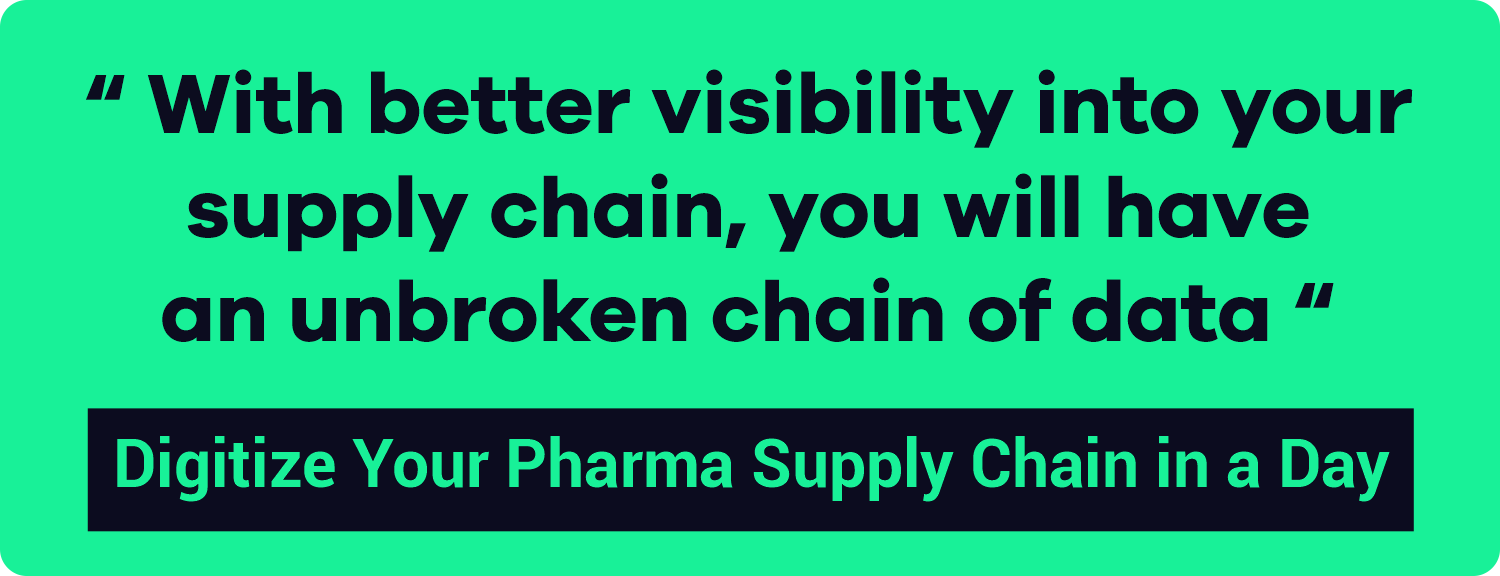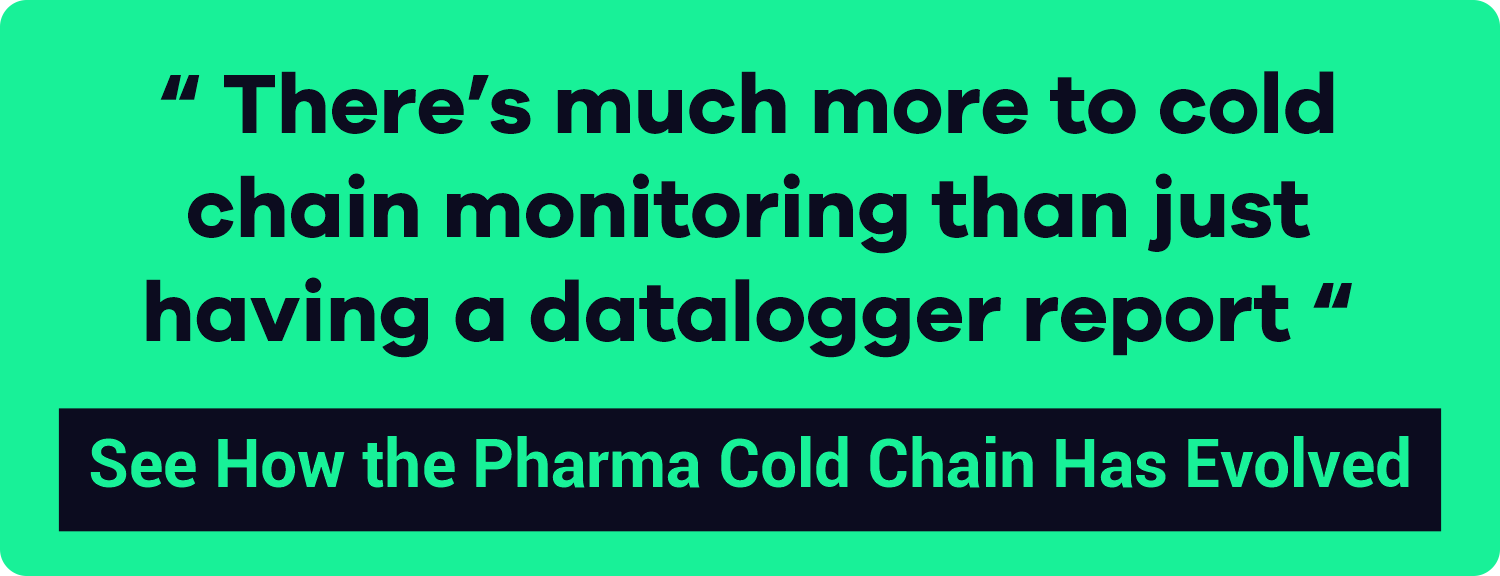Pharmaceuticals is one industry that's always standing on the verge of doing 'the next big thing' when it comes to not only medical, but also technological breakthroughs. The same goes for transporting and tracking pharma products. With the Internet of Things (IoT) having become ubiquitous, it is now possible to be with your shipment like a shadow from the time it leaves your facility until it reaches its destination with the right solution.
Let’s examine the avenues real-time supply chain visibility has opened up and how to use them to overcome the four major pharma supply chain challenges.
This is a better time than ever to be handling a pharma supply chain — when technology has allowed us to be in the know of things all the time, unlike in the recent past when all we had was limited data on location and condition. What we now have is the option to have an end-to-end, data-driven, analytics-powered digital supply chain. Real-time supply chain visibility is making it possible to fight the various pharma supply chain challenges.
A pharmaceutical supply chain mainly faces four big challenges. Here’s how having end-to-end real-time supply chain visibility can help you fight, and successfully win against these challenges.
#1: Distribution Optimization & Availability on Shelf
Distribution optimization is a significant challenge that pharma supply chain confronts. If your product is not exactly ‘niche’, it is most probably easily replaceable when not available. So, the moment your supply falls short of the demand or one of your trucks gets delayed, your competitor gains from your loss, and you might even lose that particular section of the market forever, along with your brand’s image. This calls for the need to have a real-time pharma supply chain visibility solution.
Pharma faces several difficulties — product unavailability due to expiration or transport-related delays, unavoidable overstocking so that a particular product is never out of stock, resulting in a higher working capital expenditure, and other issues such as spoilage, product recalls, theft, damage, and loss. This kind of an industry scenario requires you to:
- Optimize the supply chain in order to improve competitiveness
- Emphasize on overstocking to offset risk from competition
- Build and follow stricter compliance mandates
What Are the Challenges?
While trying to manage the above, various distribution optimization and availability challenges occur in the supply chain, some of which are:
- Expiration Dates (that limit the efficacy/viability of buffer stocking): If you overstock a particular drug, it might get expired sitting on the shelf. The challenge is to maximize stock availability but minimize overstocking — in short, to optimize the stock. But due to volatility in supply chain operations, it becomes hard to have a well laid-out JIT model.
- The Bullwhip Effect: With deficient information sharing, comes increasing overstocking when moving upstream in the supply chain. The bullwhip effect basically occurs in pharma, or for that matter, any supply chain due to unpredictability and data insufficiency.
- FIFO Management Difficulties: Without easy current and future inventory data, it isn’t possible to make smart and quick decisions on stock optimization.
- On Time but NOT in Full: In case of pharma supply chains, ‘something’s better than nothing’ doesn’t work. Partial delivery is as good as no delivery, even if it reaches on time. When you have tight SLAs to meet and face a shortfall, you need to make sure that you immediately ship the required remaining stock. This leads to higher spends on the same amount of stock. If this occurs regularly, you could also risk your business going to the competitor.
- Part-load Damage Might Mean Complete Load Rejection: Just like an on-time partial delivery, part-load damage could also lead to complete load rejections. This would mean unnecessary wastage of the remaining good packages, and added expense to resend a full-load, on time, and most probably, on an urgent basis.
How Real Time Supply Chain Visibility Can Address These Challenges?
With better visibility into your supply chain, you will have an unbroken chain of data that not only means just information, but also leads you to meaningful analysis of the situation and better, as well as timely decisions.
Here’s how better real time supply chain visibility can help you address your pharma distribution and optimization challenges:
- Better Shipping Predictability: Through unbroken visibility into your supply chain, you will know how much to ship when and where without having to risk overstocking; ultimately reducing wasteful working capital expenditure.
- Better Inventory Visibility: Wastage due to non-compliance of FIFO is a big issue when you keep a huge buffer stock. With better visibility into your inventory, there will be more efficient FIFO and “stock transfer” strategies, saving you from the loss due to spoilage.
- Better Condition Visibility in Storage & Transit: With accurate data about the location and condition of your goods both in the warehouse as well as in transit, you will be able to have a more accurate damaged inventory purge. This means you will have to weather less wastage due to cold chain interruption as well.
- Better Actionability: The biggest benefit of having accurate, real-time data on your shipment is that you can take timely actions on the anomalies, rather than coming to know about them only later, when the damage has been done. For instance, if you come to know of a package with temperature excursion while in transit using real-time alerts, you can ask the transporter/driver to deal with it right then, instead of rejecting the whole consignment because of delayed information.
#2: Drug Counterfeiting
Drug Counterfeiting is one of the biggest challenges that the global pharmaceutical industry faces. Through the years, there have been a lot of efforts to keep pharma supply chains in check for mishaps like drug counterfeit and theft, including increased government regulations — QR codes, holograms, RFID tags, blockchain.
But counterfeit drugs are still one of the most perilous things that the pharma industry has to deal with. A report by the World Health Organization suggests that 1 out of every 10 products in the worldwide drug market is counterfeit*.
Although there are many reasons for drug counterfeit happening around the world for years now, some of the major reasons are package counterfeiting, diluting drugs with knockoffs, and re-routing to more profitable markets. Here are the challenges that come in the way of preventing them:
What Are the Challenges?
- Difficulty Identifying: It is hard to identify counterfeit products outside a lab setting. It is easy to replicate tags, and unless it is at an item-level, even barcoding doesn’t help much to catch the fake.
- Difficulty Tracing: It is hard to trace compromised batches. Identifying the forged product is a big step forward, but in order to quickly and efficiently recall a product from the market, it is essential to identify which batches are authentic and which ones are compromised.
- Difficulty Locating Breaches: It is hard to pinpoint the focus area for intervention and containment. In the absence of complete and clear visibility across the supply chain and at the package level, it is not possible to locate and isolate the point of breach.
How Real-Time Supply Chain Visibility Can Address These Challenges?
With better visibility into your pharma supply chain, you will have an unbroken chain of data that not only means just information, but also leads you to meaningful analysis of the situation and better, as well as timely decisions.
Here’s how real-time supply chain visibility can help you fight the challenge of drug counterfeiting:
- Package-level Visibility Aids Batch Identification: When you have granular visibility into your pharma supply chain, you would clearly know which batch has been compromised with and which isn't without a doubt, easily picking the ones to be recalled and replaced.
- Digital Audit Trail: End-to-end visibility means a transparent chain of custody. It will enable you to identify theft at an early stage and increase the possibility of prevention.
- Risk Prediction: If you have an intelligent visibility system, data and AI can be used to predict risk by forwarders, lanes, and custodians.
#3: Cold-chain Compliance-triggered Disruptions
The IQVIA Institute for Human Data Science has estimated the losses by pharma companies to about $35 billion (Aircargo News 2019b; Buxbaum 2018; Jafferi 2019). Handling a cold chain is a different ballgame altogether. There’s much more to cold chain monitoring than just having a datalogger report. Not acting on time can go beyond compliance issues, it can lead to issues with distribution due to goods being rejected. For years we have been using active or passive data loggers to get information about our cold chains, but it’s not been enough to prevent compliance issues cascading into supply chain disruptions.
What Are the Challenges?
- Compliance Issues Trigger Logistics Disruptions: Nearly 1/4th of all vaccines that are transported, get degraded owing to incorrect shipping. If your parcel arrives in full but damaged, re-shipping is required, which is a stress on your logistics operations.
- Difficulties Pinpointing Disruption: It is hard to pinpoint the time/location/cause of cold chain disruption. You have information regarding delays, damage, or condition excursions, but neither is this information real-time, nor relevant enough. You cannot identify the cause without real-time location and condition data. For example, the reason for spoilage or damage may be high-touch handling of your goods which has nothing to do with container or storage temperatures. If you don’t know the exact reason, it is next to impossible to stop it from happening the next time as well.
- Overspending to Offset Risks: This includes arranging for another premium forwarder, spending more on the packaging, labor, fuel, and transportation, or even recalling spoiled or expired products.
- Security Challenges: What’s worse? Your vaccine stolen and sold illegally, or your goods stolen and sold illegally without maintaining them in the right temperature. Such incidents can severely impact your brand.
How Visibility Can Address These Challenges
The biggest reason for the inability to find the gaps in your pharma supply chain and resolving the problem is the lack of real, real-time, and relevant data. Here is how solving the visibility issue could completely change the fate of your pharma cold chain:
- Visibility Provides Actionability: When you’re always in the know of what’s happening in your cold chain in the warehouse and during its journey, it is easier to take corrective, and even predictive actions. For instance, with time and analysis if you come to know that a particular route always faces temperature excursions, you can change routes or prepare your shipment for it in advance, without losing time when the event actually occurs.
- Data Analytics Drive Risk Prediction: With proper visibility and predictive analytics on the go, it's easier to make informed decisions and prevent risks before they occur. With such a system in place, you can bet your bottom dollar on the predictive analytics and have a less risk-prone cold chain, or at least take actions before the disruptions take place.
- Package-level Visibility Drives Batch-Level Auditability: Not all packages in your cold chain are equally sensitive to condition variations. That’s where package-level sensing comes in handy. You are not only able to identify warm-zones and fix them, but also don’t need to discard the entire consignment because your data logger reading went wrong in the corner it was placed in.
#4: Managing Reusable Medical Devices
A big part of the pharmaceutical market belongs to reusable medical devices — devices that health care providers reuse on more than one event and patient — surgical equipment such as endoscopes, stethoscopes, colonoscopes, clamps, arthroscopic shavers, and surgical forceps. Not only are these reusable devices expensive and hard to manage — decontamination, disinfection, sterilization, regulatory considerations — but are also not very cost-effective & ROI friendly. So, healthcare providers usually acquire such devices on lease from medical device companies.
What Are the Challenges?
The major trouble in managing reusable devices is the inability to plan based on demand requirements, because you can’t avoid keeping a proper buffer stock to offset demand/supply volatility. On the other hand, if you overstock, you end up blocking a lot of working capital into managing the buffer stock, that could ideally earn from other potential users.
- Idle Stocks at Healthcare Facilities Increase Costs: These costly & specialized devices usually have a scheduled demand, but sometimes an ad hoc, emergency demand also arises. Therefore, hospitals always need some of them on hand and the burden of stocking and maintenance shifts to medical device companies, that can’t bill them until & unless the devices are actually used.
- JIT Model Isn’t an Option: Since there’s a lack of visibility, JIT becomes a dicey guesswork where you aren’t prepared to handle sudden demand spikes. This could make you lose further deals with the client as well as jeopardize your long-term relationship with them.
- Excessive Buffer Stock Leads to Working Capital Issues: More and more working capital goes into keeping the inventory stocked up all the time. The idle inventory leads to loss of time, money, and effort that goes into maintaining it, while it isn’t earning its due ROI.
How Visibility Can Address These Challenges
The only wise solution to reusable medical device management is getting enhanced real time supply chain visibility. This will offer:
- Better Demand-Supply Predictability: With better visibility, you can get more information into sales velocity making is easier to predict demand and supply. You will now be in the know of how much time your inventory takes to reach from the warehouse to the healthcare service’s facility, so you don’t have to keep excess buffer stock. You now also have end-to-end statistical analytics on how the devices are being utilized.
- Better Management in Crisis: It’s usually harder to spot fluctuations like a sudden spike in demand for some equipment during a crisis like a natural calamity or an epidemic. With real-time inventory visibility, you can correlate the data with information from other sources. For example, if you have real-time visibility into your inventory and you’re aware of a crisis (e.g., a pandemic) that could push the demand curve, you can now predict the possible increase in demand and make proactive measures to ascertain timely supply. Move Closer to a JIT Model: Better visibility gives you a proper idea of the time the inventory takes to reach the place of need, and the lead time. You may not be able to shift to a JIT model, but you can work more confidently with only calculated risk.
- Better Customer Servicing: Visibility coupled with contextual information will help you plan your probable demand and account for fluctuations in demand more efficiently. Your ability to serve the client in times of crisis is enhanced, and you don’t need to be the one to drop the ball because you’re prepared for demand-supply fluctuations.
A good supply chain optimization system allows you to plan your JIT model properly and reliably, using which, you can not only minimize the buffer inventory, but also enhance your brand image as a stable and reliable service provider even in times of crises.
In Summary
A pharma supply chain is full of complexities and unexpected but inevitable unpredictability that cannot be ignored. Even though you think you're already tracking your supply chain, if your answer to the question 'are you always on top of your pharma supply chain challenges from the first mile to the last mile?' is not affirmative, you know you're at risk.
After reading the detailed account above, you now know that just tracking isn't enough, and that you need a complete pharma supply chain monitoring system with real-time visibility in order to overcome the 4 Key Pharma Supply Chain Challenges. It’s high time you go ahead with a plan that best suits your business and your budget, all while covering risks specific to your supply chain.

















